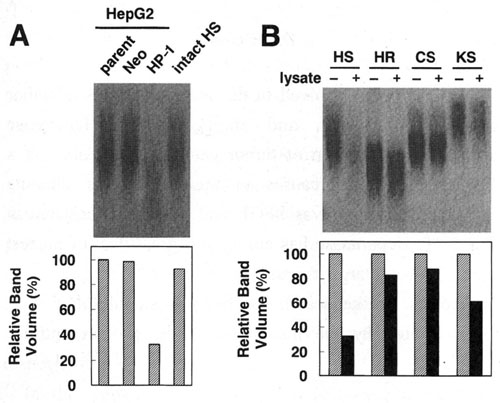ケミカルバイオロジー研究グループ(終了)
Outlines:
Heparanase is an endo-beta-D-glucuronidase and plays important roles in tumor metastasis. When tumor cells spread out, they must penetrate the extracellular matrix (ECM) and the basement membrane (BM). At that time, tumor cells secrete matrix metalloproteases and heparanase to degrade major components of ECM and BM such as type IV collagen and heparan sulfate proteoglycans. Moreover, heparanase releases several growth factors, such as bFGF and VEGF, which bind toeparan sulfate (HS) chains in ECM and BM tocause angiogenesis. Therefore, heparanase is recognized as a target molecule for antitumor agents.
Heparan sulfate (HS) was labeled with N-(4-nitro-2,1,3,-benzoxadiazoyl)-N-methyl-2-aminoacetohydrazide (NBD-CO-Hz). The cells were washed suspended in PBS (pH 6.0)., and disrupted by 5 cycles of freezing and thawing. The lysates were centrifuged at 15,000 rpm for 15 min at 4 oC. A mixture of 27 ul of cell lysate and 3 ul of fluorescence-labeled HS solution (0.1 ug/ul in PBS, pH 6.0) was incubated at 37 oC for 24 h. Following the addition of 6 ul of sampling solution (36% glycerol, 1% bromophenol blue), 20 ul of each reaction mixture was subjected to SDS-PAGE (20%), and the gel was scanned by the Variable Mode Imager Typhoon 9400 (Amersham Biosciences).
その他:阻害活性が見出された物質はがん転移阻害活性評価を外部機関に依頼することも可能。
 |
|
Consequence of the transfection of heparanase gene (A) and substrate specificity of the HpeG2-HP-1 lysate. |
References:
-
N. S. Lai, S. Simizu, D. Morisaki, M. Muroi, H. Osada.
Requirement of the conserved, hydrophobic C-terminus region for the activation of heparanase.
Exp. Cell. Res., 314, 2834-2845 (2008). -
K. Ishida, T. Teruya, S. Simizu, H. Osada.
Exploitation of Heparanase Inhibitors from Microbial Metabolites Using an Efficient Visual Screening System.
J. Antibiot., 57, 136-142 (2004).


